Brittle Deformation in the Neoproterozoic Basement of Southeast Brazil: Traces of Intraplate Cenozoic Tectonics
Abstract
:1. Introduction
2. Geodynamic and Geological Settings of the Study Area
3. Materials and Methods
4. Results: Data Analyses
4.1. Lineament Domain Analysis
4.2. Field Structural Data
5. Discussion
6. Conclusions
Author Contributions
Funding
Data Availability Statement
Acknowledgments
Conflicts of Interest
References
- Trouw, R.A.J.; Heilbron, M.; Ribeiro, A.; Paciullo, F.; Valeriano, C.M.; Almeida, J.C.H.; Schobbenhaus, C.; Bellizzia, A. Geologic Map of South America; Ministry of Mines and Energy: Brasilia, Brazil, 2000.
- Brito Neves, B.B.D.; Teixeira, W.; Tassinari, C.C.G.; Kawashita, K. A contribution to the sudivision of the Precambrian in South America. Rev. Bras. Geociências 1990, 20, 267–276. [Google Scholar] [CrossRef]
- Neves, B.B.D.B.; Fuck, R.A.; Pimentel, M.M. The Brasiliano collage in South America: A review. Braz. J. Geol. 2014, 44, 493–518. [Google Scholar] [CrossRef]
- Sadowski, G.R.; Motidome, M.J. Brazillan Megafaults. Andean Geol. 1987, 31, 61–75. [Google Scholar]
- Torsvik, T.H.; Rousse, S.; Labails, C.; Smethurst, M.A. A new scheme for the opening of the South Atlantic Ocean and the dissection of an Aptian salt basin. Geophys. J. Int. 2009, 177, 1315–1333. [Google Scholar] [CrossRef] [Green Version]
- Hasui, Y. A grande colisão pré-cambriana do sudeste brasileiro e a estruturação regional. Geociências 2010, 141–169. [Google Scholar]
- Lima, C.; Nascimento, E.; Assumpção, M. Stress orientations in Brazilian sedimentary basins from breakout anaysis: Implications for force models in the South American Plate. Geophys. J. Int. 1997, 130, 112–124. [Google Scholar] [CrossRef] [Green Version]
- Bianchi, M.B.; Assumpção, M.; Rocha, M.P.; Carvalho, J.M.; Azevedo, P.A.; Fontes, S.L.; Costa, I.S. The Bra-zilian seismographic network (RSBR): Improving seismic monitoring in Brazil. Seismol. Res. Lett. 2018, 89, 452–457. [Google Scholar] [CrossRef]
- Riccomini, C. O Rift Continental do Sudeste do Brasil. Unpublished Ph.D. Thesis, Institute of Geosciences of the University of São Paulo, São Paulo, Brazil, 1989. [Google Scholar]
- Riccomini, C.; Sant’Anna, L.G.; Ferrari, A.L. Evolução Geológica do Rift Continental do Sudeste do Brasil. In Geologia do Continente Sul-Americano: Evolução da Obra de Fernando Flávio Marques de Almeida; Beca Produções Culturais: São Paulo, Brazil, 2004; pp. 383–405. [Google Scholar]
- Almeida, F.F.M.; Carneiro, C.D.R. Origem e evolução da Serra do Mar. Rev. Bras. De Geociências 1998, 28, 135–150. [Google Scholar] [CrossRef]
- Tello Saenz, C.A.; Hackspacher, P.C.; Hadler Neto, J.C.; Iunes, P.J.; Guedes, S.; Paulo, S.R.; Ribeiro, L.F.B. Recognition of creta-ceous, paleocene and neogene tectonic reactivation, through apatite fis¬sion-track analysis, in Precambrian areas of the Southeast Brazil: Association with the South Atlantic Ocean opening. J. S. Am. Earth Sci. 2003, 15, 137–142. [Google Scholar] [CrossRef]
- Tello Saenz, C.A.; Hadler Neto, J.C.; Iunes, P.J.; Guedes, S.; Hackspacher, P.C.; Ribeiro, L.F.B.; Paulo, S.R.; Osório, A.M.A. Thermo-chronology of the South American Platform in the state of São Paulo, Brazil, through apatite fission tracks. Radiat Meas 2005, 39, 635–640. [Google Scholar] [CrossRef]
- Zalán, P.V.; Oliveira, J.A.B. Origem e evolução estrutural do Sis¬tema de Riftes Cenozóicos do Sudeste do Brasil. Bol. Geociências Petrobrás 2005, 13, 269–300. [Google Scholar]
- Hackspacher, P.C.; Ribeiro, L.F.B.; Ribeiro, M.C.S.; Fetter, A.H.; Hadler Neto, J.C.; Tello Saenz, C.A.; Dantas, E.L. Con-solidation and break-up of the South American platform in Southeastern Brazil: Tectonothermal and denudation histories. Gondwana Res. 2004, 7, 91–101. [Google Scholar] [CrossRef]
- Hackspacher, P.C.; De Godoy, D.F.; Ribeiro, L.F.B.; Neto, J.C.H.; Franco, A.O.B. Modelagem térmica e geomorfologia da borda sul do Cráton do São Francisco: Termocronologia por traços de fissão em apatita. Rev. Bras. Geociências 2007, 37, 76–86. [Google Scholar] [CrossRef]
- Franco-Magalhaes, A.O.B.; Hackspacher, P.C.; Glasmacher, U.A.; Saad, A.R. Rift to post-rift evolution of a “passive” continental margin: The Ponta Grossa Arch, SE Brazil. Int. J. Earth Sci. 2010, 99, 1599–1613. [Google Scholar] [CrossRef]
- Cogné, N.; Gallagher, K.; Cobbold, P.R. Post-rift reactivation of the onshore margin of southeast Brazil: Evidence from apatite (U–Th)/He and fission-track data. Earth Planet. Sci. Lett. 2011, 309, 118–130. [Google Scholar] [CrossRef]
- Cogné, N.; Gallagher, K.; Cobbold, P.R.; Riccomini, C.; Gautheron, C. Post-breakup tectonics in southeast Brazil from thermochronological data and combined inverse-forward thermal history modeling. J. Geophys. Res. Space Phys. 2012, 117, 2-009340. [Google Scholar] [CrossRef] [Green Version]
- Hasui, Y. Neotectônica e Aspectos Fundamentais da Tectônica Ressurgente no Brazil. In 1o. Workshop Sobre Neotectônica e Sedimentação Cenozóica Continental no Sudeste Brasileiro, Belo Horizonte; Boletim no. 11; Sociedade Brasileira de Geologia: São Paulo, Brazil, 1990; pp. 1–31. [Google Scholar]
- Saadi, A. Neotectônica da Plataforma Brasileira: Esboço e interpretação preliminares. Rev. Geonomos 1993, 1, 1–15. [Google Scholar] [CrossRef]
- Riccomini, C.; Peloggia, A.; Saloni, J.; Kohnke, M.; Figueira, R. Neotectonic activity in the Serra do Mar rift system (southeastern Brazil). J. S. Am. Earth Sci. 1989, 2, 191–197. [Google Scholar] [CrossRef]
- Salamuni, E.; Ebert, H.D.; Hasui, Y. Morfotectônica da bacia sedimentar de curitiba. Rev. Bras. De Geociências 2004, 34, 469–478. [Google Scholar] [CrossRef] [Green Version]
- Freitas, R.O. Sobre a origem da Bacia de São Paulo. Bol. Paul. De Geogr. 1951, 9, 60–64. [Google Scholar]
- Takiya, H. Estudo da Sedimentação Neogênico-Quaternário no Município de São Paulo: Caracterização dos Depósitos e Suas Implicações na Geologia Urbana. Unpublished Ph.D. Thesis, Institute of Geosciences of the University of São Paulo, São Paulo, Brazil, 1997. [Google Scholar]
- Rodriguez, S.K. Geologia Urbana da Região Metropolitana de São Paulo. Unpublished Ph.D. Thesis, Institute of Geosciences of the University of São Paulo, São Paulo, Brazil, 1998. [Google Scholar]
- Ab’Saber, A.N. Geomorfologia da região do Jaraguá. São Paulo. An. Assoc. Geógr. Bras 1947, 1, 32–40. [Google Scholar]
- Ab’Saber, A.N. Successão de Quadros Paleogeográficos no Brasil do Triássico ao quaternário; Universidade católica de São Paulo: São Paulo, Brazil, 1951. [Google Scholar]
- Almeida, F.F.M. As camadas d de São Paulo e a Tectônica da Serra da Cantareira. Bol. Da Soc. Bras. De Geol. 1955, 4, 23–40. [Google Scholar]
- Sígolo, J.B.; Altafini, M. Dobras atectônicas em crostas ferruginosas de Pirapora do Bom Jesus-SP e Bacia Terciária de São Paulo. Geologia USP. Série Científica 2001, 1, 45–58. [Google Scholar] [CrossRef] [Green Version]
- Watanabe, A.S. Estudo Geomorfológico na Borda Norte da Bacia de São Paulo–Pirituba. Unpublished Master’s Dissertation, Faculty of Philosophy, Languages and Human Sciences, University of São Paulo, São Paulo, Brazil, 1979. [Google Scholar]
- Carneiro, C.D.R.; Rodrigues, E.D.P.; Coutinho, J.M.V. Microestruturas e relações metamorfismo-deformação do Grupo São Roque na faixa entre o Pico do Jaraguá e a Serra dos Cristais-SP. Rev. Bras. De Geociências 1984, 14, 97–110. [Google Scholar] [CrossRef] [Green Version]
- Henrique-Pinto, R.; Janasi, V.D.A. Metaconglomerados e rochas associadas do Grupo São Roque a norte da cidade de São Paulo, Brasil. Rev. Bras. Geociências 2010, 40, 409–425. [Google Scholar] [CrossRef] [Green Version]
- Coutinho, J.M.V. Meta-Conglomerado e rochas associadas no Município de São Paulo. Bol. Fac. Filos. Ciecirc;Ncias E Let. Univ. São Paulo. Mineral. 1955, 13, 6. [Google Scholar] [CrossRef]
- Cordani, U.G.; Campos, A.C.; Davino, A.; Björnber, A.J.S. Geologia da Região do Jaraguá. Bol. Soc. Bras. Geol. 1961, 10, 73–91. [Google Scholar]
- Machado, R.; Demange, M.; Viallete, Y. Idades Geocronológicas Rb/Sr Da Granitogênese Brasiliana No Segmento Setentrional Da Faixa Ribeira, Estado do Rio de Janeiro. SBG/Núcleo BA/SE. Congr. Bras. Geol 1996, 39, 8–40. [Google Scholar]
- Coutinho, J.M.V. Mapa geológico da Grande São Paulo, 1:100.000; EMPLASA: São Paulo, Brazil, 1980. [Google Scholar]
- CPRM. Mapa Geológico do Estado de São Paulo; Ministério de Minas e Energia—Secretaria de Geologia, Mineração e Transformação Mineral: Brasília, Brazil, 2006.
- Janasi, V.D.A.; Ulbrich, H.H. Late Proterozoic granitoid magmatism in the state of São Paulo, southeastern Brazil. Precambrian Res. 1991, 51, 351–374. [Google Scholar] [CrossRef]
- Hasui, Y.; Almeida, F.F.M.D.; Brito Neves, B.B.D. As Estruturas Brasilianas. In Proceedings of the XXX Congresso Brasileiro de Geologia, Recife, Brazil, November 1978. [Google Scholar]
- Gurgueira, M.D. Correlação de Dados Geológicos e Geotécnicos na Bacia de São Paulo. Unpublished Ph.D. Thesis, Institute of Geosciences of the University of São Paulo, São Paulo, Brazil, 2013. [Google Scholar]
- Silva, T.B.D. Tectônica Fanerozoica ao Longo da Zona de Cisalhamento Jundiuvira, SP. Unpublished Ph.D. Thesis, Institute of Geosciences of the University of São Paulo, São Paulo, Brazil, 2011. [Google Scholar]
- Peyerl, W.R.L.; Salamuni, E.; Sanches, E.; Nascimento, E.R.D.; Santos, J.M.; Gimenez, V.B.; Farias, T.F.S. Rea-tivation of Taxaquara Fault and its morphotectonic influence on the evolution of Jordão River catchment, Paraná, Brasil. Braz. J. Geol. 2018, 48, 553–573. [Google Scholar] [CrossRef]
- Fernandes, A.J.; Amaral, G. Cenozoic tectonic events at the border of the Parana Basin, São Paulo, Brazil. J. S. Am. Earth Sci. 2002, 14, 911–931. [Google Scholar] [CrossRef]
- Wise, D.U.; Funiciello, R.; Parotto, M.; Salvini, F. Topographic lineament swarms: Clues to their origin from domain analysis of Italy. GSA Bull. 1985, 96, 952–967. [Google Scholar] [CrossRef]
- Cianfarra, P.; Salvini, F. Ice sheet surface lineaments as nonconventional indicators of East Antarctica bedrock tectonics. Geosphere 2014, 10, 1411–1418. [Google Scholar] [CrossRef] [Green Version]
- Cianfarra, P.; Salvini, F. Lineament Domain of Regional Strike-Slip Corridor: Insight from the Neogene Transtensional De Geer Transform Fault in NW Spitsbergen. Pure Appl. Geophys. 2015, 172, 1185–1201. [Google Scholar] [CrossRef] [Green Version]
- Lucianetti, G.; Cianfarra, P.; Mazza, R. Lineament domain analysis to infer groundwater flow paths: Clues from the Pale di San Martino fractured aquifer, Eastern Italian Alps. Geosphere 2017, 13, 1729–1746. [Google Scholar] [CrossRef] [Green Version]
- Rossi, C.; Cianfarra, P.; Salvini, F.; Mitri, G.; Massé, M. Evidence of transpressional tectonics on the Uruk Sulcus region, Ganymede. Tectonophysics 2018, 749, 72–87. [Google Scholar] [CrossRef]
- Wise, D.U. Pseudo-radar topographic shadowing for detection of sub-continental sized fracture systems. In Proceedings of the Sixth International Symposium in Remote Sensing of Environment, Ann Arbor, MI, USA, 13–16 October 1969; pp. 603–615. [Google Scholar]
- Cianfarra, P.; Salvini, F. Quantification of fracturing within fault damage zones affecting Late Proterozoic carbonates in Svalbard. Rend. Fis. Acc. Lincei 2016, 27, 229–241. [Google Scholar] [CrossRef]
- Salvini, F. Slope-Intercept-Density Plots: A New Method for Line Detection in Images. In Proceedings of the 1985 International Geoscience and Remote Sensing Symposium(IGARSS’85), Amherst, MA, USA, 7–9 October 1985; pp. 715–720. [Google Scholar]
- Wise, D.U.; Vincent, R.J. Rotation axis method for detecting conjugate planes in calcite petrofabric. Am. J. Sci. 1965, 263, 289–301. [Google Scholar] [CrossRef]
- Fossen, H. Structural Geology, 2nd ed.; Cambridge University Press: Cambridge, UK, 2016; p. 524. ISBN 9781107057647. [Google Scholar]
- Tarantola, A. Inverse Problem Theory and Methods for Model Parameter Estimation: Philadelphia; Society for Industrial and Applied Mathematics: Philadelphia, PA, USA, 2005. [Google Scholar]
- Zalán, P.V.; Wolff, S.; Conceição, J.C.; Astolfi, M.A.M.; Vieira, I.S.; Appi, C.T.; Zanotto, O.A. Tectônica e Sedimentação da Bacia do Paraná. In Atas do III Simpósio Sul-Brasileiro de Geologia; Sociedade Brasileira de Geologia: Curitiba, Brazil, 1987; Volume 1, pp. 441–477. [Google Scholar]
- Morales, N. Neotectônica em Ambiente Intraplaca: Exemplos da Região Sudeste do Brasil. Unpublished Free-Docent Thesis, Institute of Geosciences and Exact Sciences of the São Paulo State University, São Paulo, Brazil, 2005. [Google Scholar]
- Pinheiro, M.R.; Cianfarra, P.; Villela, F.N.J.; Salvini, F. Tectonics of the Northeastern border of the Parana Basin (Southeastern Brazil) revealed by lineament domain analysis. J. S. Am. Earth Sci. 2019, 94, 102231. [Google Scholar] [CrossRef]
- Wise, D.U.; McCrory, T.A. A new method of fracture analysis: Azimuth versus traverse distance plots. GSA Bull. 1982, 93, 889. [Google Scholar] [CrossRef]
- Hiruma, S.T.; Riccomini, C.; Modenesi-Gauttieri, M.C. Neotectônica no planalto de Campos do Jordão, SP. Rev. Bras. De Geociências 2001, 31, 375–384. [Google Scholar] [CrossRef]
- Negrão, A.P.; Ramos, R.R.C.; Sanson, M.D.S.R.; Mello, C.L. Mapa geológico do cenozoico da região da bacia de Volta Redonda (RJ, segmento central do Rifte Continental do Sudeste do Brasil): Identificação de novos grabens e ocorrências descontínuas, e caracterização de estágios tectonossedimentares. Braz. J. Geol. 2015, 45, 273–291. [Google Scholar] [CrossRef] [Green Version]
- Brêda, T.C.; Mello, C.L.; Moraes, A. Influence of preexisting structures on the variation of neotectonic paleostress orientation in an area of the Southeastern Brazilian Margin. Braz. J. Geol. 2021, 51. [Google Scholar] [CrossRef]
- Giro, J.P.; Almeida, J.; Guedes, E.; Bruno, H. Tectonic inheritances in rifts: The meaning of NNE lineaments in the continental rift of SE-Brazil. J. S. Am. Earth Sci. 2021, 108, 103225. [Google Scholar] [CrossRef]
- Riccomini, C. Tectonismo Gerador e Deformador dos Depósitos Sedimentares Pós-Gondvânicos da Porção Centro-Oriental do Estado de São Paulo e Áreas Vizinhas. Free-Docent Thesis, University of São Paulo, São Paulo, Brazil, 1995. [Google Scholar]
- Facincani, E.M. Morfotectônica da Depressão Periférica Paulista, Cuesta Basáltica e Planalto Interior. Regiões de São Carlos, Rio Claro e Piracicaba-SP. Unpublished Ph.D. Thesis, Institute of Geosciences and Exact Sciences of the São Paulo State Uni-versity, São Paulo, Brazil, 2000. [Google Scholar]
- Hasui, Y.; Borges, M.S.; Morales, N.; Costa, J.B.S.; Bemerguy, R.L.; Jimenez-Rueda, J.R. Intraplate neotectonics in South-East Brazil. In International Geological Congress; Abstract Volume, 31; IUGS: Rio de Janeiro, Brazil, 2000. [Google Scholar]
- Francheteau, J.; Pichon, X.L. Marginal fracture zones as structural framework of continental margins in South Atlantic Ocean. AAPG Bull. 1972, 56, 991–1007. [Google Scholar]
- Vasconcelos, D.L.; Bezerra, F.H.; Clausen, O.R.; Medeiros, W.E.; de Castro, D.L.; Vital, H.; Barbosa, J.A. Influence of Precambrian shear zones on the formation of oceanic fracture zones along the continental margin of Brazil. Mar. Pet. Geol. 2019, 101, 322–333. [Google Scholar] [CrossRef]
- Barão, L.M.; Trzaskos, B.; Angulo, R.J.; De Souza, M.C.; Daufenbach, H.F.; Santos, F.A.; Vasconcellos, E.M.G. Deformational structures developed in volcanic sequences as a product of tectonic adjustments in the South Atlantic Ocean. J. S. Am. Earth Sci. 2020, 104, 102812. [Google Scholar] [CrossRef]
- Santos, M.; Ladeira, F.S.B. Tectonismo em perfis de alteração na serra da Itaqueri (SP): Análise através de indicadores cinemáticos de Falhas [Tectonics in weathering profiles at Itaqueri ridge (SP): Analysis through kinematics indicators of faults] UNESP. Geociências 2006, 25, 135–149. [Google Scholar]
- Silva, T.P.; Mello, C.L. Reativações neotectônicas na Zona de Cisalhamento do Rio Paraíba do Sul (sudeste do Brasil). Geologia USP. Série Científica 2011, 11, 95–111. [Google Scholar] [CrossRef] [Green Version]
- Pinheiro, M.R.; Queiroz Neto, J.P. Neotectônica e evolução do relevo da região da Serra de São Pedro e do Baixo Piracicaba—Sudeste do Brasil [Neotectonics and landform development of the São Pedro ridge and lower Piracicaba river region/Southeastern Brazil]. Rev. Brasil. Geomorf. 2015, 16, 593–613. [Google Scholar]
- da Silva, B.A.; Calegari, M.R.; Pinheiro, M.R.; Fujita, R.H. Lithostructural and tectonic determinants in the geomorphic evolution of the Basalt Plateau – Southern Brazil. J. S. Am. Earth Sci. 2021, 110, 103351. [Google Scholar] [CrossRef]
- Bird, D.E.; Hall, S.A. Early seafloor spreading in the South Atlantic: New evidence for M-series magnetochrons north of the Rio Grande Fracture Zone. Geophys. J. Int. 2016, 206, 835–844. [Google Scholar] [CrossRef] [Green Version]
- Alves, E.D.C.; Maia, M.; Sichel, S.E.; Campos, C.M.P.D. Zona de fratura de Vitória-Trindade no Oceano Atlântico sudeste e suas implicações tectônicas. Rev. Bras. De Geofísica 2006, 24, 117–127. [Google Scholar] [CrossRef]
- Zanutta, A.; Negusini, M.; Vittuari, L.; Martelli, L.; Cianfarra, P.; Salvini, F.; Mancini, F.; Sterzai, P.; Creati, N.; Dubbini, M.; et al. Victoria Land, Antarctica: An Improved Geodynamic Interpretation Based on the Strain Rate Field of the Current Crustal Motion and Moho Depth Model. Remote. Sens. 2020, 13, 87. [Google Scholar] [CrossRef]
- Zanutta, A.; Negusini, M.; Vittuari, L.; Cianfarra, P.; Salvini, F.; Mancini, F.; Sterzai, P.; Dubbini, M.; Galeandro, A.; Capra, A. Monitoring geodynamic activity in the Victoria Land, East Antarctica: Evidence from GNSS measurements. J. Geodyn. 2017, 110, 31–42. [Google Scholar] [CrossRef]
- Lesti, C.; Giordano, G.; Salvini, F.; Cas, R. Volcano tectonic setting of the intraplate, Pliocene-Holocene, Newer Volcanic Province (southeast Australia): Role of crustal fracture zones. J. Geophys. Res. Space Phys. 2008, 113. [Google Scholar] [CrossRef]
- Salvini, F.; Brancolini, G.; Busetti, M.; Storti, F.; Mazzarini, F.; Coren, F. Cenozoic geodynamics of the Ross Sea region, Antarctica: Crustal extension, intraplate strike-slip faulting, and tectonic inheritance. J. Geophys. Res. Space Phys. 1997, 102, 24669–24696. [Google Scholar] [CrossRef]
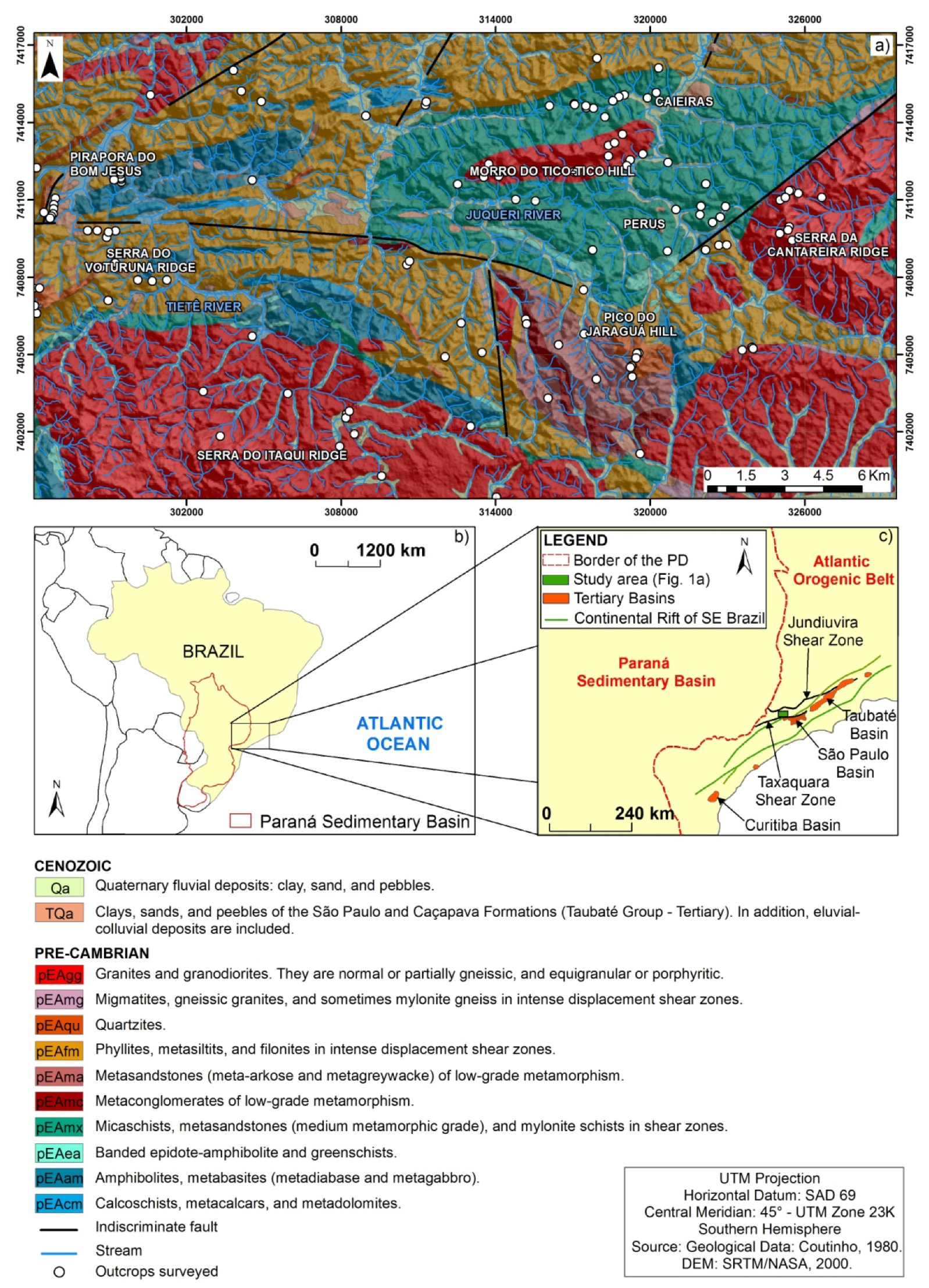
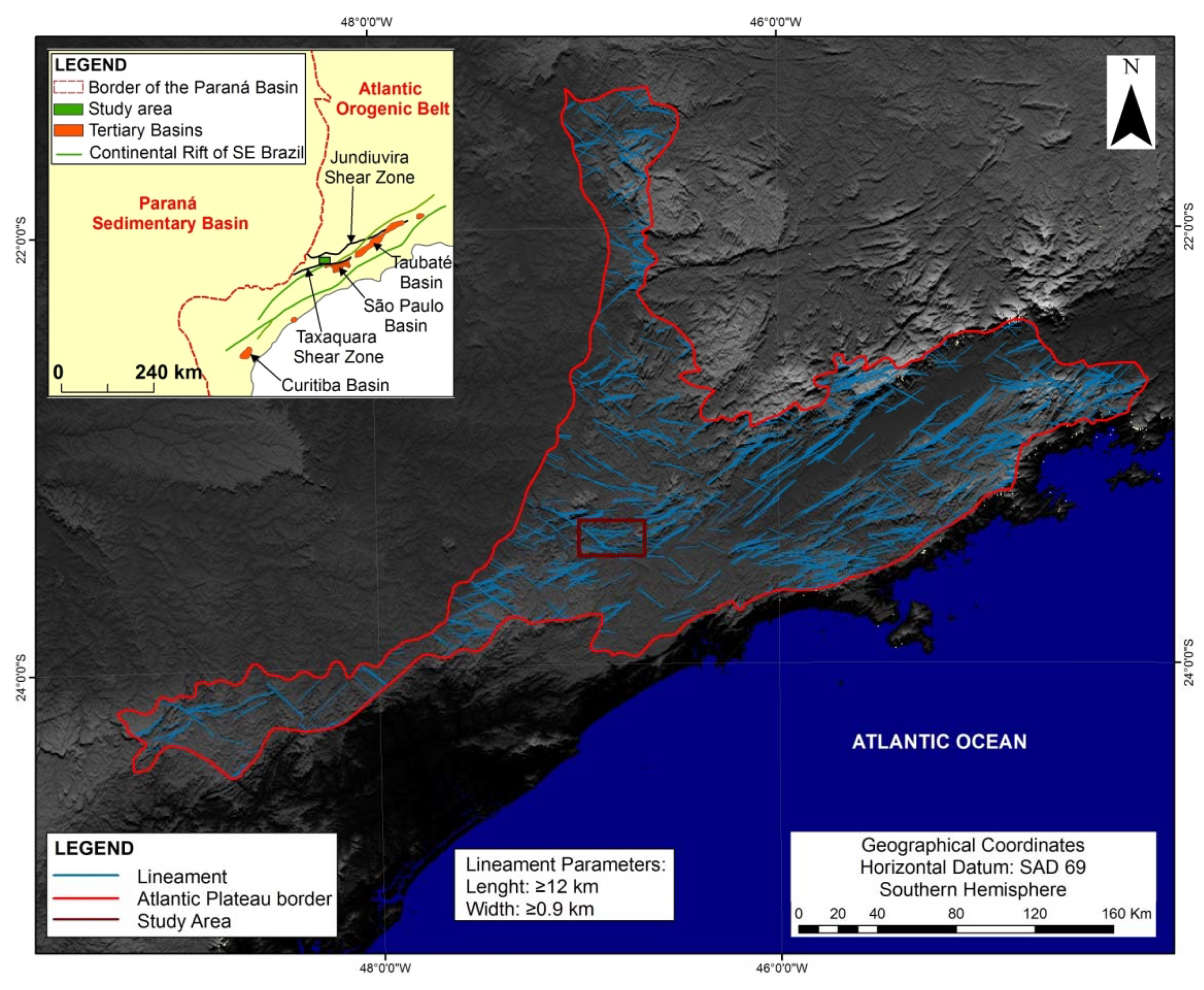

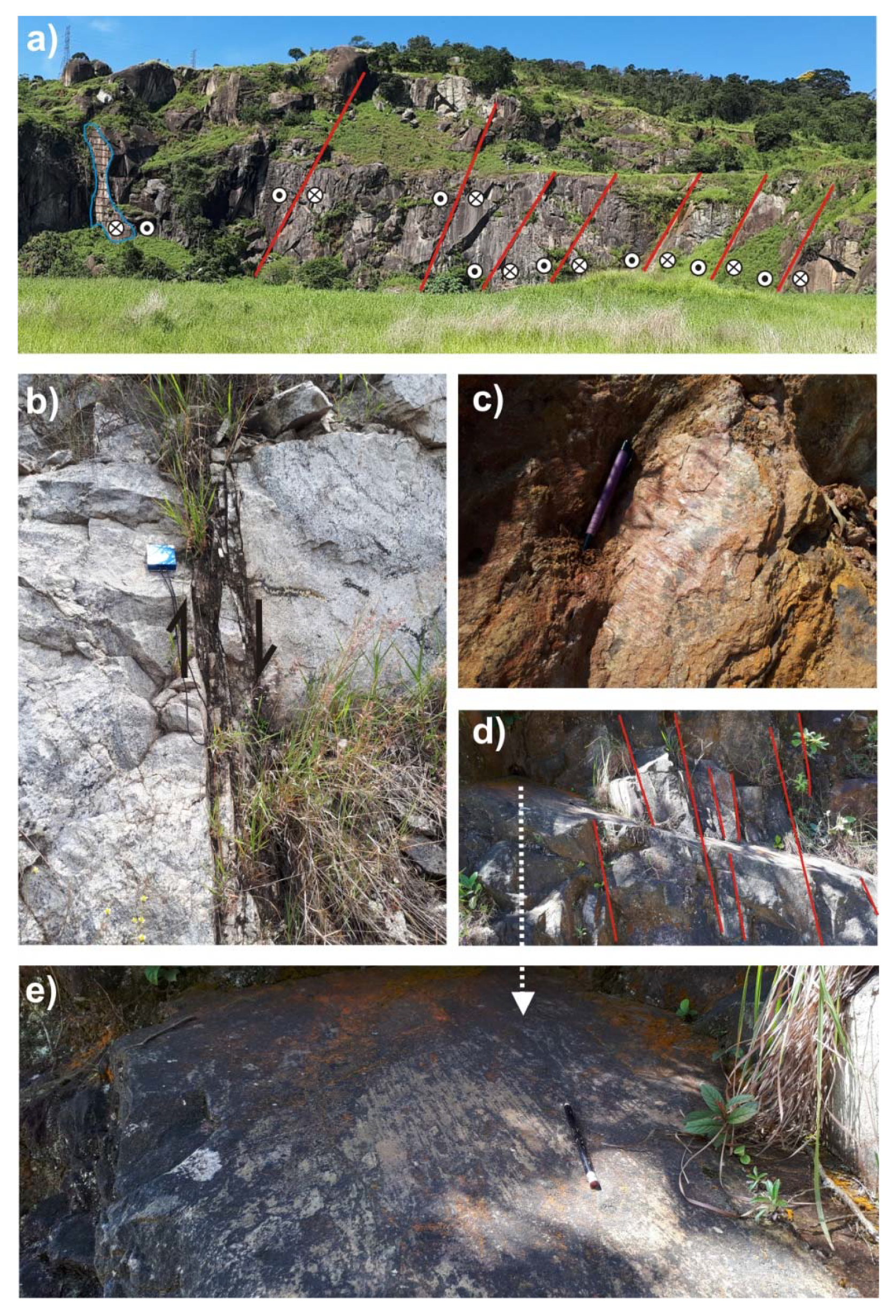
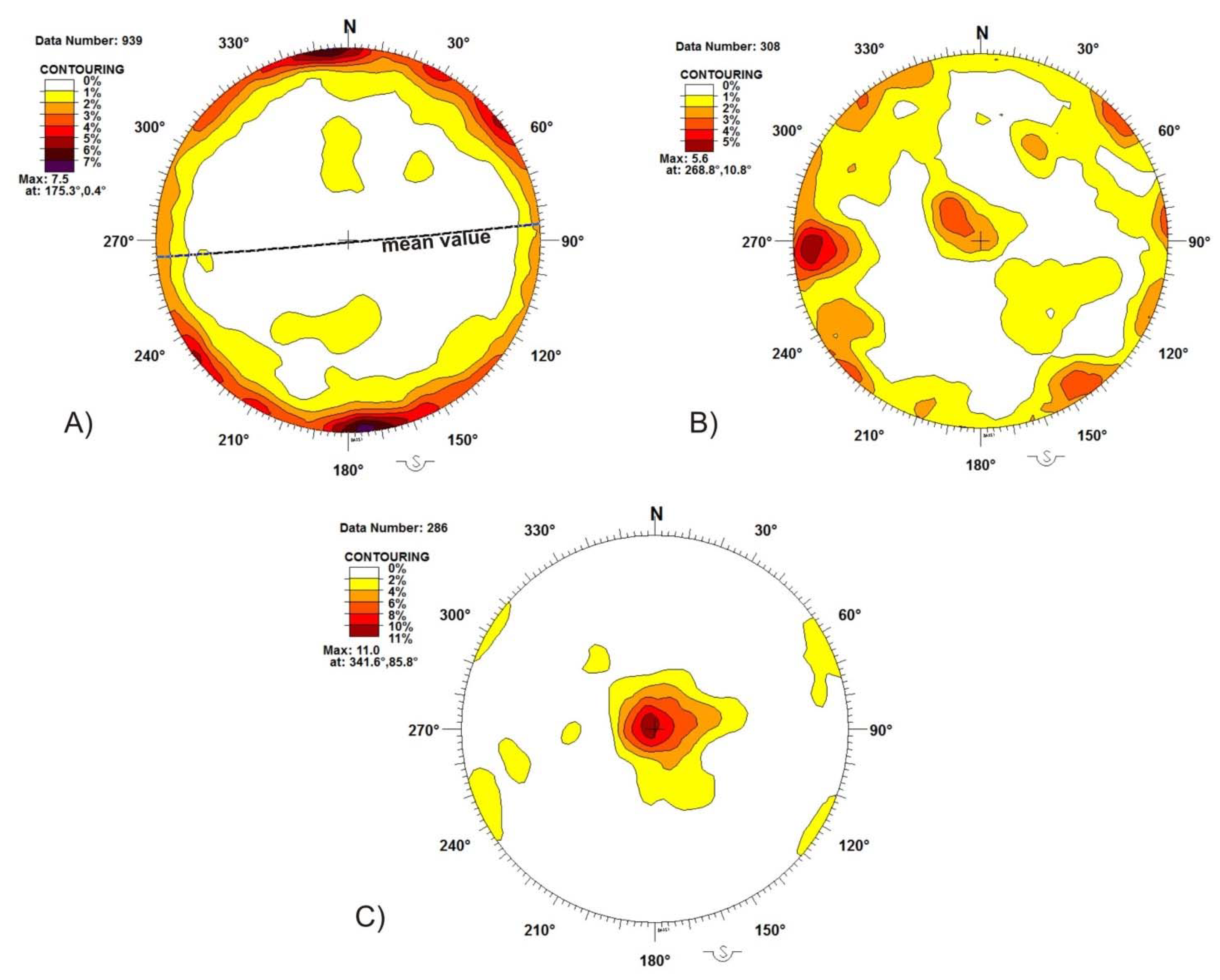
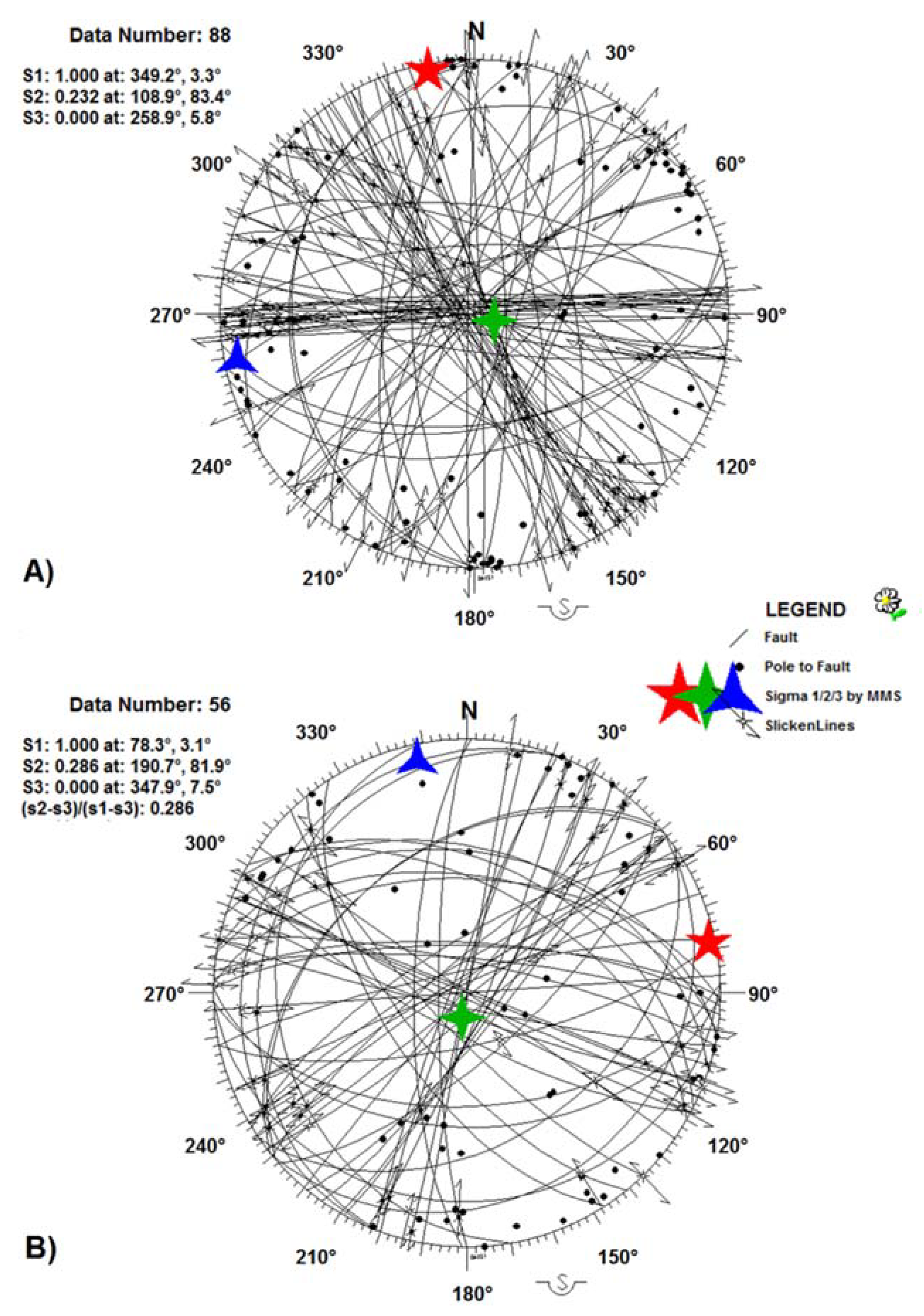
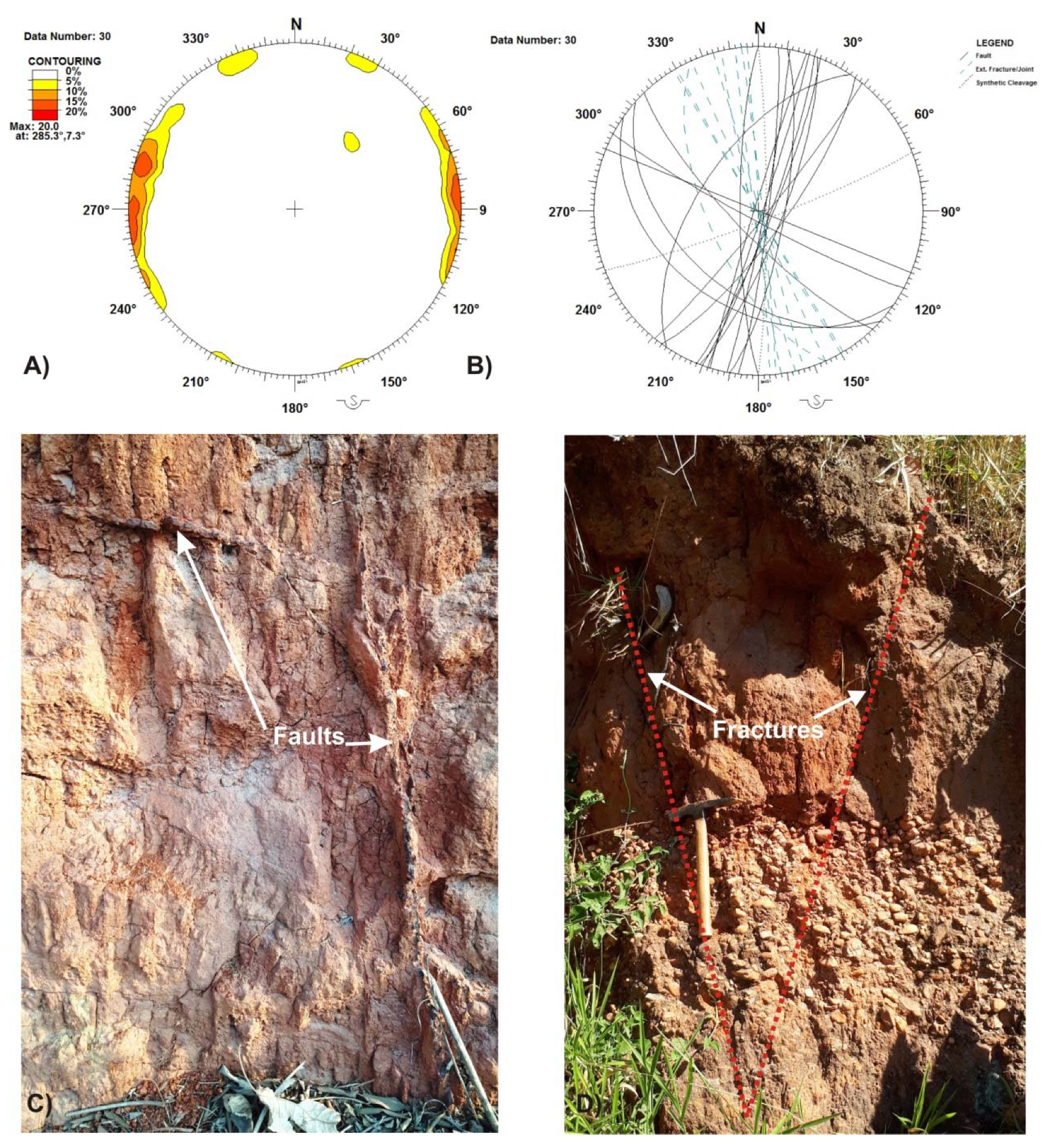


Publisher’s Note: MDPI stays neutral with regard to jurisdictional claims in published maps and institutional affiliations. |
© 2021 by the authors. Licensee MDPI, Basel, Switzerland. This article is an open access article distributed under the terms and conditions of the Creative Commons Attribution (CC BY) license (https://creativecommons.org/licenses/by/4.0/).
Share and Cite
Pinheiro, M.R.; Cianfarra, P. Brittle Deformation in the Neoproterozoic Basement of Southeast Brazil: Traces of Intraplate Cenozoic Tectonics. Geosciences 2021, 11, 270. https://doi.org/10.3390/geosciences11070270
Pinheiro MR, Cianfarra P. Brittle Deformation in the Neoproterozoic Basement of Southeast Brazil: Traces of Intraplate Cenozoic Tectonics. Geosciences. 2021; 11(7):270. https://doi.org/10.3390/geosciences11070270
Chicago/Turabian StylePinheiro, Marcos Roberto, and Paola Cianfarra. 2021. "Brittle Deformation in the Neoproterozoic Basement of Southeast Brazil: Traces of Intraplate Cenozoic Tectonics" Geosciences 11, no. 7: 270. https://doi.org/10.3390/geosciences11070270
APA StylePinheiro, M. R., & Cianfarra, P. (2021). Brittle Deformation in the Neoproterozoic Basement of Southeast Brazil: Traces of Intraplate Cenozoic Tectonics. Geosciences, 11(7), 270. https://doi.org/10.3390/geosciences11070270





